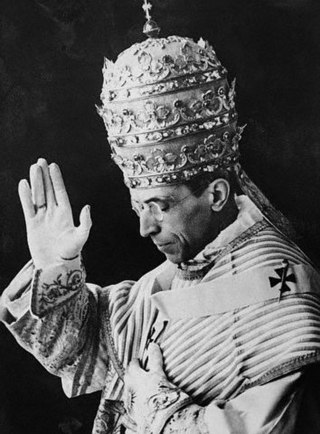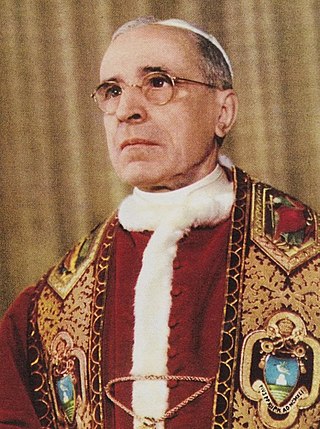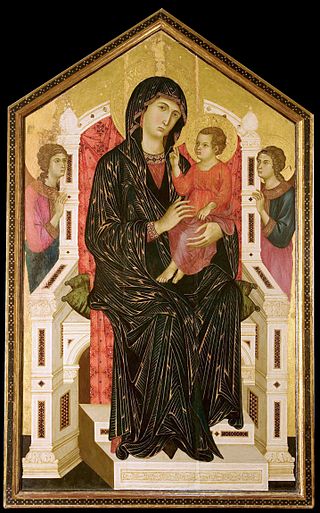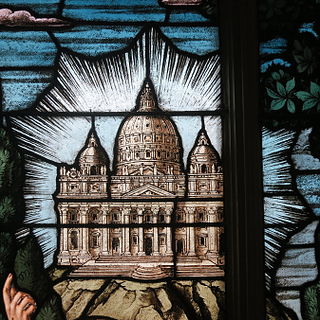
In Christian theology, the term Body of Christ has two main but separate meanings: it may refer to Jesus Christ's words over the bread at the celebration of the Jewish feast of Passover that "This is my body" in Luke 22:19–20, or it may refer to all individuals who are "in Christ" 1 Corinthians 12:12–14.

Catholic Mariology is Mariology in Catholic theology. According to the Immaculate Conception taught by the Catholic Church, she was conceived and born without sin, hence Mary is seen as having a singular dignity above the saints, receiving a higher level of veneration than all angelic spirits and blessed souls in heaven. Catholic Mariology thus studies not only her life but also the veneration of her in daily life, prayer, hymns, art, music, and architecture in modern and ancient Christianity throughout the ages.
Humani generis is a papal encyclical that Pope Pius XII promulgated on 12 August 1950 "concerning some false opinions threatening to undermine the foundations of Catholic Doctrine". It primarily discussed, the encyclical says, "new opinions" which may "originate from a reprehensible desire of novelty" and their consequences on the Church.

Summi Pontificatus is an encyclical of Pope Pius XII published on 20 October 1939. The encyclical is subtitled "on the unity of human society". It was the first encyclical of Pius XII and was seen as setting "a tone" for his papacy. It criticizes alleged major errors of the time, such as ideologies of racism, cultural superiority and the totalitarian state. It also sets the theological framework for future encyclical letters such as Mystici corporis Christi (1943). The encyclical laments the destruction of Poland, denounces the Molotov–Ribbentrop Pact, and calls for a restoration of independent Poland.
Subsistit in is a Latin phrase which appears in Lumen gentium, the document on the church from the Second Vatican Council of the Catholic Church. Since the council, the reason for use of the term "subsists in" rather than simply "is" has been disputed. Generally, those who see little or no change in church teaching in Vatican II insist on the equivalence of subsistit in and "is". Those who point to a new, ecumenical thrust in Vatican II insist that the term was introduced as a compromise after much discussion, and acknowledges new elements in the council's teaching.
The church invisible, invisible church, mystical church or church mystical, is a Christian theological concept of an "invisible" Christian Church of the elect who are known only to God, in contrast to the "visible church"—that is, the institutional body on earth which preaches the gospel and administers the sacraments. Every member of the invisible church is "saved", while the visible church contains all individuals who are saved though also having some who are "unsaved". According to this view, Bible passages such as Matthew 7:21–27, Matthew 13:24–30, and Matthew 24:29–51 speak about this distinction.
Mediator Dei is a papal encyclical issued by Pope Pius XII on 20 November 1947. It was the first encyclical devoted entirely to liturgy.

The late years of the pontificate of Pope Pius XII were characterized by a hesitancy in personnel decisions. After a major illness in 1954, he redirected his energies from Vatican clergy to the concerns of lay people.
Sebastiaan Peter Cornelis Tromp was a Dutch Jesuit priest, theologian, and Latinist, who is best known for assisting Pope Pius XII in his theological encyclicals, and Pope John XXIII in the preparation for Vatican II. He was an assistant to Cardinal Alfredo Ottaviani during the Council and professor of Catholic theology at the Pontifical Gregorian University from 1929 until 1967.

Ad Caeli Reginam is an encyclical of Pope Pius XII, given at Rome, from St. Peter's Basilica, on the feast of the Maternity of the Blessed Virgin Mary, the eleventh day of October, 1954, towards the end of the Marian year, in the sixteenth year of his Pontificate. The encyclical is an important element of the Mariology of Pope Pius XII. It established the feast Queenship of Mary.

Fulgens corona is an encyclical by Pope Pius XII, given at St. Peter's, Rome, on 8 September 1953, the Feast of the Nativity of the Blessed Virgin Mary, in the fifteenth year of his Pontificate. The encyclical proclaims a Marian year for 1954, to commemorate the centenary of the definition of the dogma of the Immaculate Conception of the Virgin Mary.

The theology of Pope Pius XII is reflected in his forty-one encyclicals, as well as speeches and nearly 1000 messages, during his almost 20-year pontificate. The encyclicals Mystici corporis and Mediator Dei advanced the understanding of membership and participation in the Catholic Church. The encyclical Divino afflante Spiritu began opening the door to historical-critical biblical studies. But his magisterium was far larger and is difficult to summarize. In numerous speeches Catholic teaching is related to various aspects of life, education, medicine, politics, war and peace, the life of saints, Mary, the mother of God, things eternal and temporal.

Ingruentium malorum is an encyclical of Pope Pius XII on reciting the rosary, issued on September 15, 1951, the Feast of the Seven Sorrows of the Virgin Mary:
It is an appeal for an intensification of the traditional October Rosary devotions, making a particular recommendation for the family recitation of the Rosary, begging Our Lady to obtain peace for individuals, for families, for peoples, for nations, and for the Church throughout the world.

The Mariology of the popes is the theological study of the influence that the popes have had on the development, formulation and transformation of the Roman Catholic Church's doctrines and devotions relating to the Blessed Virgin Mary.

Mariological papal documents have been a major force that has shaped Roman Catholic Mariology over the centuries. Mariology is developed by theologians on the basis not only of Scripture and Tradition but also of the sensus fidei of the faithful as a whole, "from the bishops to the last of the faithful", and papal documents have recorded those developments, defining Marian dogmas, spreading doctrines and encouraging devotions within the Catholic Church.

Le pèlerinage de Lourdes is the only encyclical of Pope Pius XII issued in French. It includes warnings against materialism on the centenary of the apparitions at Lourdes. It was given at Rome, from St. Peter's Basilica, on the feast of the Visitation of the Most Holy Virgin, July 2, 1957, the nineteenth year of his pontificate.
Ecclesiam Suam is an encyclical of Pope Paul VI on the Catholic Church given at St. Peter's, Rome, on the Feast of the Transfiguration, 6 August 1964, the second year of his Pontificate.

The relations between Pope Pius XII and Judaism have long been controversial, especially those questions that surround Pope Pius XII and the Holocaust. Other issues involve Pius's Jewish friendships and his attitude towards the new state of Israel.

Corpus Mysticum: Essai sur L'Eucharistie et l’Église au moyen âge was a book written by Henri de Lubac, published in Paris in 1944. The book aimed to, in de Lubac's words, retrieve the doctrine that "the Church makes the eucharist and the eucharist makes the church".

Catholic ecclesiology is the theological study of the Catholic Church, its nature, organization and its "distinctive place in the economy of salvation through Christ." Such study shows a progressive development over time being further described in revelation or in philosophy. Here the focus is on the time leading into and since the Second Vatican Council (1962–1965).














